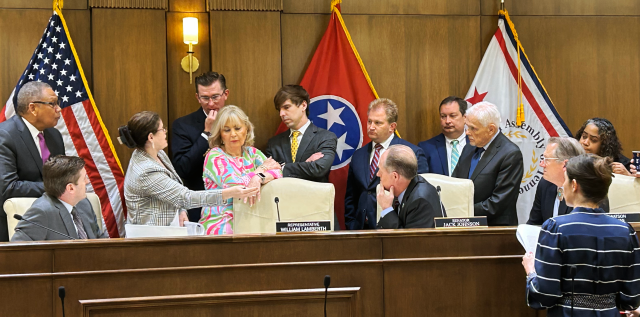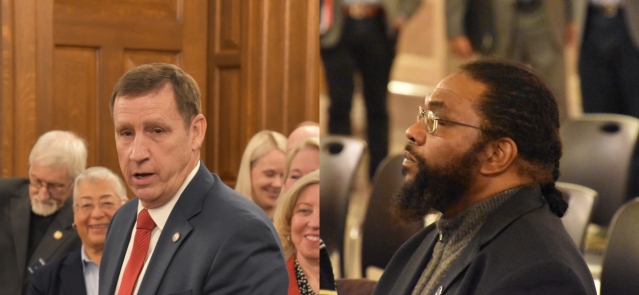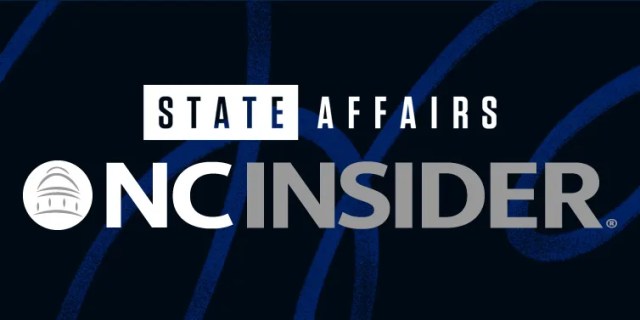YOU DON’T SAY
“People in other areas may need different solutions for their students.”
Tanae McLean, the Chief Communications Officer at Mooresville Graded School District, on schools opening early without state permission. (WFAE Radio, 8/06/24)
Power Lines
Laura Leslie, WRAL News, 8/06/24
North Carolina is due to receive $57 million to retool a key transmission line, North Carolina and federal energy leaders announced Tuesday. The funding to shore up the Lee-Milburnie Transmission line is part of the Biden administration’s investment of $30 billion in energy infrastructure statewide through the Bipartisan Infrastructure Law ($10 billion) and the Inflation Reduction Act ($20 billion).
John Podesta, a senior advisor to President Joe Biden, was among the speakers Tuesday at the Duke Energy Renewable Control Center in Garner. Podesta discussed what the project aims to accomplish:
- Reduce electricity interruptions during extreme weather
- Help bring 1,600 megawatts of solar energy and 260 megawatts of storage
- Cost 30% less than constructing new transmission
- Bring benefits to communities
- Create 550 jobs
“It improves your liability, it saves money, it helps build clean power, it reduces pollution and creates good-paying jobs,” Podesta said. “As my mother used to say when I was a kid, ‘What’s not to like?’”
The $57 million grant will go to the North Carolina Department of Environmental Quality and the State Energy Office. It will help retool a key transmission line between Wake and Wayne counties, replacing wood poles with steel and adding more power capacity. Gov. Roy Cooper said it will make the grid stronger during future storms.
The updates will take a few years, but Tropical Storm Debby is just a couple of days away from North Carolina.
Kendal Bowman, president of Duke Energy’s utility operations in North Carolina, said Duke Energy has been making changes already and crews are as prepared as they can be for Tropical Storm Debby. She said there are 6,900 crews in North Carolina ready to go.
U.S. Secretary of Energy Jennifer Granholm toured the Duke Energy Facility on Tuesday to highlight the Biden administration’s spending on the nation’s electric power grid. She said the grid is just as important today as highways or water systems. She said the grid system has more than 5 million miles of distribution lines.
“That is the largest machine on Earth, the grid is and yet, much of our grid was built in the 1950s, 1960s and hasn’t been upgraded,” Granholm said.
U.S. Rep. Deborah Ross, D-North Carolina, discussed the specifics of the Bipartisan Infrastructure Law. “I’m pleased to say that working with my colleagues from both parties on this issue, we were ultimately successful,” Ross said. Ross said the law includes a program to help connect clean energy projects to the grid and improve the state’s power sectors’ resilience against the threats of climate change and extreme weather events.
Cooper said Tuesday it will lead to fewer outages and shorter outages when they do happen. He said it will also keep consumer costs down because the funding goes to maintenance costs that Duke Energy customers won’t have to cover in their monthly bills. “With our growing economy, we happen to be the third-fastest growing state in the country … the demand for energy increases,” Cooper said.
Cooper mentioned CNBC’s high rankings of North Carolina as a top state for business. He also said North Carolina is a leader in electric vehicle manufacturing. At least four companies have announced plans for battery factories in central North Carolina.
“With all of that success comes the infrastructure challenges that we know that we have to face,” Cooper said.
Cooper said North Carolina has to produce power at a lower cost and cleaner than it was in the past. “We need to make sure we meet the needs of businesses that don’t want to leave a carbon footprint,” Cooper said.
On Tuesday, Granholm discussed the importance of North Carolina having a “21st-century grid” and having the proper energy infrastructure.
“We want to make sure that states have the opportunity not just to use these grid-enhancing technologies, like reconductoring, but also to choose to underground for example, which is more expensive,” Granholm said. “And so, having a federal partnership to be able to make that resiliency play is important.” [Source]
Teacher Retraining
Will Doran, WRAL News, 8/06/24
Tens of thousands of North Carolina elementary school teachers have now been retrained in how to teach young children how to read, the state’s top education official announced Tuesday.
Schools have long struggled with getting all children proficient at reading, in North Carolina and nationwide. Literacy issues significantly worsened during the Covid-19 pandemic. And while test scores have bounced back more recently, they’re still not back to pre-pandemic levels, WRAL reported last year.
Superintendent of Public Instruction Catherine Truitt said the state put 44,000 teachers through the new course as of June, revamping how they teach reading in grades K-5. She made the announcement Tuesday at the monthly Council of State meeting of all the state’s top executive branch leaders. By the time they get to high school, Truitt said, most students in North Carolina can’t read proficiently. The new elementary-level tactics aim to fix that problem.
“The way that we’ve been teaching reading for the past few decades in this country does not align with how what the research tells us about how the brain learns to read,” she said Tuesday.
Truitt said the new techniques are expected to help improve those numbers. Republican state lawmakers passed a new law in 2021 revamping how reading is taught, and now the teachers charged with carrying out that new curriculum — officially called LETRS — know how to do it. Training started in 2021 and ended this spring. “This fall, our kindergartners will be coming to school for the first time having a teacher who absolutely has completed their LETRS training,” Truitt said.
She added that the most recent scores have already seen schools cutting down on the achievement gap between white and nonwhite students, with substantial testing gains among Black, Hispanic and Native American students in particular. “We’re incredibly proud not just of our kids, but our teachers who worked so hard to do this,” she said.
Truitt and the state lawmakers behind the new program are Republicans. But unlike some of the politically divisive culture-war issues that have focused on public schools recently, there is bipartisan agreement on the new reading approach. Also on Tuesday Democratic Gov. Roy Cooper praised the program and Truitt’s implementation of it.
“I’ve sat on the floor of elementary schools,” Cooper said. “I have looked at the data. I’m sold on the effectiveness of the science of reading. This is something that we all came together to do in a bipartisan way. We all agree this is the way to go. I think now, the challenge is to make a real investment in teachers and teacher assistants to make sure we keep them and they are well trained.” [Source]
Running Mate
Danielle Battaglia, The News & Observer, 8/06/24
Vice President Kamala Harris chose Minnesota Gov. Tim Walz as her running mate Tuesday morning, drawing strong reactions from North Carolina politicians on both sides of the aisle.
“Governors like him know what it takes to get the job done,” Gov. Roy Cooper said, “and he will be an outstanding vice president, doubling down on his work to support the middle class families, protect reproductive freedom and safeguard our democracy.”
Cooper told reporters Tuesday that people who know Walz like him a lot and that he was excited about the pick. Cooper and Walz are both members of the Democratic Governors Association, which Walz chairs. The association works to support the party’s governors in 23 states and four territories. And many of the lawmakers that Harris was choosing from for her running mate came from the association’s membership.
Cooper was thought to be on Harris’ short list for vice president, but he said he pulled himself out of the race almost immediately. He said in a statement Tuesday that Walz would be “an outstanding running mate.”
Attorney General Josh Stein, a Democrat running to succeed Cooper, who is term-limited from running for reelection, threw his support behind Walz Tuesday. “A veteran, educator and dedicated public servant, I have no doubt he will fight for the American people just as he has fought for the people of Minnesota,” Stein said. “Let’s get to work!”
Stein’s opponent, Lt. Gov. Mark Robinson’s team, said Walz and Stein are no different. Robinson’s communication director, Mike Lonergan, said Walz’s selection shows that “the Democrats are committed to far-left extremism up and down the ballot.”
Members of North Carolina’s congressional delegation also began weighing in. U.S. Rep. Alma Adams, a Democrat from Charlotte and the most senior member of the delegation, said in a written statement that Walz has her “full support and confidence.”
“This strategic pick couldn’t be a better option, especially against extremist JD Vance,” Adams said. “Unlike Trump and his pick, these two will know how to work together to solidify a strong and progressive America that we can all be proud of.”
U.S. Rep. Deborah Ross said the focus of the Harris and Walz campaign “is one of opportunity, freedom and progress.”
U.S. Rep. Richard Hudson, a Republican from Southern Pines who leads that Republican National Congressional Committee, called Walz Harris’ “partner in crime” and a “liberal lapdog.”
Republicans have criticized Walz for protecting gender-affirming care and abortion access, legalizing recreational marijuana and expanding background checks to purchase guns.
“President Trump and JD Vance will make America safe and prosperous again,” Hudson said. “Harris and Walz will destroy our country with their Far Left, America-Last agenda.”
Former Rep. Mark Walker, a Republican from North Carolina, called Harris’ decision a “big win for President Trump and JD Vance.” “Horrendous record in Congress,” Walker wrote on social media. Walker serves as the Faith Outreach Advisor for the Republican National Committee. [Source]
Storm Cancellation
Sarah Gleason, Wilmington StarNews, 8/06/24
Kamala Harris will no longer be visiting the Research Triangle this Thursday due to Tropical Storm Debby, according to the campaign. Tropical Storm Debby could bring high winds, a lot of rainfall and possible flooding to the area, according to the National Weather Service, and Gov. Roy Cooper declared a state of emergency on Monday evening. The Harris campaign did not have an update on when the presumptive Democratic presidential nominee would return to the area.
Harris’ visit was a part of a battleground tour beginning in Pennsylvania Tuesday where she is expected to appear with her newly chosen running mate, Minnesota Gov. Tim Walz, a pick reported by Reuters that cited CNN.
JD Vance also announced a visit to the Tar Heel State for Thursday. [Source]
Musk PAC
Kyle Ingram, The News & Observer, 8/06/24
A political action committee created by billionaire tech CEO Elon Musk has drawn the attention of the North Carolina attorney general’s office and the State Board of Elections following a complaint about its collection of personal data.
The complaint, filed by political activist and former candidate for state insurance commissioner David Wheeler, alleges that Musk’s America PAC “is pretending to be running an online voter registration drive. However, they are simply collecting data on voters and are fraudulently collecting and retaining confidential voter information.”
Pat Gannon, a spokesperson for the State Board of Elections, confirmed on Tuesday that the board has opened an investigation into the allegations.
“North Carolina law makes it a crime for someone to fail to submit a voter’s registration form if that person has told a voter that they would be submitting the voter’s registration form,” Gannon told The News & Observer.
A spokesperson for Attorney General Josh Stein, a Democrat who is running for governor, said Tuesday that his office is looking into the Super PAC as well, though it has not opened its own formal investigation.
This comes after reporting from CNBC found that America PAC’s website asked for personal information from visitors and promised to help them register to vote, but failed to do so in some states. According to CNBC, site visitors in states where the presidential election is not expected to be competitive were quickly directed to their state’s voter registration page. But voters in battleground states, like North Carolina, were prompted to give further personal information and, after submitting it, were not taken to a voter registration page.
Visiting a voter registration link on Tuesday from one of the PAC’s tweets brought the user to a website with the following pop-up message: “It was brought to our attention on August 2 that some people may have been unable to complete the registration process on this website on August 1 and 2. If you had any difficulty, please try to complete the registration process again or email [email protected] for assistance.”
Per state law, voters can only register online through the DMV website, not a private website.
America PAC, which Musk said he created, is supporting former President Donald Trump against Vice President Kamala Harris in 2024. The PAC did not respond to a request for comment on Tuesday.
According to FEC filings, the group had raised nearly $9 million by the end of June. Super PACs can accept unlimited donations from corporations and individuals, but cannot work directly with candidates.
Musk, who is CEO of Tesla and SpaceX as well as the owner of X, initially said he would give around $45 million a month to Trump’s campaign, according to The Wall Street Journal.
Musk later called this report “ridiculous” on X and said he was making “some donations” to the PAC but at a “much lower level.”
The secretary of state in Michigan has also opened an investigation into the PAC, with a spokesperson for her office telling CNBC, “Every citizen should know exactly how their personal information is being used by PACs, especially if an entity is claiming it will help people register to vote in Michigan or any other state.” [Source]
Fiscal Policy
Brett Stover, State Affairs Pro, 8/06/24
Tax policy, K-12 education funding and housing are among this year’s top issues noted by state fiscal analysts across the country. Along with state economic conditions and long-term liabilities, those topics are top of mind for legislative fiscal offices, a senior policy analyst with the National Conference of State Legislatures said Tuesday in Lousiville.
Eric Syverson said the list — which will be released in a forthcoming report — comes from a new database the organization is compiling.
In 2024, the top tax policy implemented by states was property tax relief, Syverson said. Other popular policies included income tax cuts, business incentives, tax benefits for families and sales tax exemptions:
- Fifteen states enacted property tax relief this year, Syverson said. Those cuts came primarily as homestead exemptions, either broad or targeted. For example, Kansas exempted the first $75,000 of home value from a homeowner’s property tax bill.
- Many states implemented new income taxes or accelerated previously enacted cuts. Syverson said there were fewer cuts this year than last year, but states are still cutting income taxes at a historically high pace.
- There’s been increased interest by legislatures in using tax policy to help families with children, particularly to address the cost of child care. For example, Georgia, Kansas and Wisconsin made those types of tax benefits more generous this year. Syverson predicted more federal action on child tax credits in 2025.
- Six states enacted business-specific sales tax exemptions this year, and seven did so for certain goods and services.
Michael D’Arcy, director of U.S. public finance for Fitch Ratings, gave attendees at the NCSL session a “reality check” on some of the top concerns identified by policymakers: declining revenues, economic uncertainty, demographic changes, structural deficits and state credit ratings.
The top concern, declining state revenue, is a very real issue, D’Arcy said. Revenue declined for 16 states in the last fiscal year, and year-over-year revenue growth across all states has decelerated. Some of those declines are the result of economic conditions. But D’Arcy said it’s a “largely engineered phenomenon” because of states’ recently enacted tax cuts.
There are reasons for concern over the economy, but D’Arcy said Fitch is skeptical of some of the economic indicators that point to a coming recession. For example, he said recent increases in the U.S. unemployment rate are a “statistical anomaly” because the numbers are driven by an increase in young, unskilled immigrant workers.
Fitch doesn’t have any states on a negative outlook, and no state’s credit rating is in an “immediate danger of going down,” D’Arcy said.
As for structural deficits — where a government consistently spends more than it makes in revenue — Fitch’s state credit team doesn’t see reason for concern over the next few years. D’Arcy said the “economy would have to really hit a recession” for those deficits to become major problems.
There’s been “unprecedented” increases in teacher salaries over the past few years, said Michelle Exstrom, director of the National Conference of State Legislatures’ education program. The growth rate of teacher compensation has caught up with the private sector for the first time in years.
In 2023 and 2024, lawmakers across the country introduced 191 bills addressing special student populations — such as special education, English-language learners and at-risk students — the most of any education topic.
Part of that figure includes a new trend, Exstrom said: funding specifically to help homeless students, a group that graduates at significantly lower rates.
The biggest outstanding at-risk funding issue? Exstrom said states are still trying to figure out how to ensure the money actually goes to those particular student groups after it’s sent to school districts.
Other major school funding issues in 2024 include reducing schools’ reliance on property tax revenue, reforms to school funding formulas and big efforts to rethink schooling, including through avenues such as voucher programs and community schools.
State and local governments reported $3 trillion in long-term debt as of 2021, according to Fatima Yousofi, a principal associate for Pew Charitable Trusts. The good news, she said, is that states have made progress in recent years, particularly in funding their pension liabilities.
Additionally, deferred costs of infrastructure maintenance are estimated to be in the range of $1 trillion to $2 trillion.
Yousofi said climate change will add to that bill through various avenues, including road and bridge repair and updates to states’ water systems.
Heather Wilson, a senior policy specialist for the National Conference of State Legislatures, said the four primary ways states are addressing the nation’s housing shortage are through stability, easing zoning restrictions, development incentives and efforts to increase home ownership. State lawmakers have introduced 1,913 housing-related bills so far this year, Wilson said, and 336 have passed. She cited the Joint Center for Housing Studies’ 2024 report, which showed the nation is 1.5 million units short of meeting its housing needs and no state has a sufficient supply of affordable rental housing.
Google Lawsuit
WRAL News, 8/06/24
A judge’s ruling against Google in a nationwide antitrust lawsuit Monday was not just the biggest victory in decades for that type of consumer protection issue, North Carolina Attorney General Josh Stein said Tuesday, but also a good reminder of the positive work government can do.
What was a loss for Google and its multi-billion-dollar advertising business, Stein said, is a major win for individual privacy as well as for competition in the marketplace. Ads should become cheaper to buy if Google faces more competition, he said, leading to savings for businesses that could hypothetically be passed down to consumers.
“We have all suffered degradation of our personal privacy because Google, given its dominance, is able to suck up more and more and more information about everything about us —and then market that information to advertisers — and charge all of us in the economy more money as a result,” Stein said, calling Monday’s ruling “the biggest antitrust victory in a generation.”
The ruling found that Google has a monopoly in internet search, with about 90% of all search traffic. A key allegation of the lawsuit, which the judge’s ruling focused on, was that Google maintains its monopoly in part by paying other companies — cell phone manufacturers, internet browsers and more — billions of dollars every year for them to make Google the default option for all their users. Google spent $26 billion on such payments in 2021 alone.
Google collects data on the millions of people who use its search function each day, storing their search history and activity for 18 months. It can then charge top dollar to sell that information about its users, and what they’re searching for, to advertisers.
The highly anticipated decision issued by U.S. District Judge Amit Mehta comes nearly a year after the start of a trial pitting the U.S. Justice Department against Google in the country’s biggest antitrust showdown in a quarter century. Kent Walker, Google’s president of global affairs, said the company intends to appeal Mehta’s findings. “This decision recognizes that Google offers the best search engine, but concludes that we shouldn’t be allowed to make it easily available,” Walker said.
The years-long lawsuit against Google was backed by the Donald Trump administration, the Joe Biden administration and numerous state governments.
Such complex litigation requires the legal teams of just a few states to take the lead for the rest, and North Carolina was among those leading the lawsuit and its legal strategy. Stein praised his staff attorneys who handled some of the key work before and during the 10-week-long trial last year, and said the win should refresh confidence in government.
“A lot of times people feel like government doesn’t work,” Stein said. “The hard work of government takes time. … But if you are persistent, and you are focused on what the ultimate goal is, government can work and make a difference in people’s lives.” [Source]
Teacher Spending
Rebecca Noel, The Charlotte Observer, 8/06/24
Teachers in North Carolina spend an average of more than $1,300 out-of-pocket on school supplies per year, according to a new survey.
That makes the state the fourth most expensive in the country for teachers when it comes to classroom expenses. The average teacher in North Carolina spends $1,338 per year on classroom supplies, exceeding the national average of $915.
The study, conducted last month by CouponBirds, found 93% of teachers use their own money to pay for school supplies like pens, paper and classroom decorations.
According to the nation’s largest teacher’s union, the National Education Association, over 90% of teachers spend their own money on school supplies.
While teachers can earn a tax deduction of up to $300 for qualifying classroom expenses, that still means spending potentially hundreds of dollars out-of-pocket for many.
“Schools will provide basic furniture, but it varies from school to school,” Melissa Bucka, a Charlotte-Mecklenburg Schools kindergarten teacher, told The Charlotte Observer. “You want to create an environment that you’re happy with but that’s also inviting and fun for the kids.”
A spokesperson for CMS told the Observer each school receives an “instructional supply allotment” to aid with needed supplies, while 105 of the district’s 186 schools also have access to federal Title I funds.
Each school’s principal, alongside the CMS procurement department and school treasurers, decides how those funds will be spent. Parents also are tasked with buying school supplies for their students.
North Carolina educators reported higher spending on classroom materials than even educators in many states with higher living costs and average teacher salaries, including California, New York and Hawaii.
The average salary for teachers in North Carolina was around $58,300 in the 2023-24 school year, up 3% from the previous year. However, the state dropped once again in the NEA’s yearly rankings of average teacher pay in all 50 states and D.C., from 38th to 41st.
The states with lower average teacher salaries than North Carolina are Arkansas, Florida, Kansas, Louisiana, Mississippi, Missouri, Montana, South Dakota, Tennessee and West Virginia. [Source]
Mooresville Schools
Ann Doss Helms, WFAE Radio, 8/06/24
It’s hard to imagine a more wholesome group of lawbreakers than the folks who are welcoming students back to Mooresville Graded Schools on Wednesday. At an open house Monday, teachers dispensed hugs and treats as K-2 students and their parents checked out Rocky River Elementary School.
North Carolina’s school calendar law requires most districts to wait until Aug. 26 to bring kids back this year. It’s a move designed to ensure a uniform summer vacation season for the tourism industry. But a growing number of school boards have decided it’s more important to synchronize calendars with the community colleges that offer tuition-free classes to high school students and to give first-semester exams before winter break. This year Mooresville is among 28 districts opening early without state permission.
Most will bring students back next week. Mooresville starts earlier to build in longer breaks at the end of each quarter.
“After the first nine weeks we have a one-week fall break. Then at Christmas we have two and a half weeks. And then at the end of third quarter we have a week’s spring break,” said Mooresville Chief Communications Officer Tanae McLean.
The only penalty from the state is a letter scolding districts for ignoring the law. Two North Carolina districts — Union County in 2023 and Carteret County this summer — were forced to return to the late-August start date after residents sued to challenge early openings.
Districts such as Charlotte-Mecklenburg Schools, which is complying with the law, have lobbied lawmakers to grant flexibility. Every year multiple calendar flexibility bills are introduced. But this year, once again, the General Assembly adjourned without granting flexibility or putting teeth into the law.
McLean says the early start is popular with Mooresville employees and families. “It’s really about just letting us have local control and do what’s right for our students here,” she said. “And then people in other areas may need different solutions for their students.”
The situation is similar across the state line. South Carolina law says districts must wait until the third Monday in August — Aug. 19 this year — to start classes. But only two South Carolina districts are waiting that long, with the rest claiming an exemption for modified year-round calendars. South Carolina schools in the Charlotte region started bringing students back last week.
Here’s the schedule of North Carolina districts opening before Aug. 26, according to a report to the General Assembly:
- Aug. 7: Mooresville.
- Aug. 8: Rowan-Salisbury**, Surry, Stanly.
- Aug. 12: Clinton city, Granville, Henderson, Iredell-Statesville, Hyde, Kannapolis city, Lexington city, Polk, Rutherford, Warren, Winston Salem-Forsyth.
- Aug. 13: Cabarrus, Elkin city, Mount Airy city, Person County.
- Aug. 14: Avery*, Cleveland, Gaston, Lee, Lincoln, Halifax, Harnett, Stokes, Washington, Yadkin.
- Aug. 19: Alleghany*, Ashe*, Graham*, Haywood*, Jackson*, Mitchell*, Sampson, Swain*, Watauga*, Yancey*.
*Some districts in the mountains have waivers to open early because they tend to have a lot of snow days.**Rowan-Salisbury Schools has an exemption tied to persistently low performance.
Year-round schools and college-based high schools are also allowed to start early. [Source]
Voluntary Evacuation
Port City Daily, 8/06/24
As Debby has put eastern North Carolina under a tropical storm watch, some area governments and municipalities have declared states of emergency. In Brunswick County — expected to get the brunt of the storm with heavy rains and flooding — commissioner chairman Randy Thompson signed off Tuesday morning on the emergency proclamation. It affects unincorporated areas of the county and initiates a voluntary evacuation for low-lying and flood-prone areas.
“Don’t take this storm for granted simply because it is labeled a tropical storm,” he wrote in a statement. “There will be severe weather impacts throughout the week, and it is up to all of us to stay alert and do everything we can to be prepared and safe.”
Coastal North Carolina, from Brunswick to Pender counties have been elevated from a tropical storm watch to a warning as of noon Tuesday, with storm surge and tornado watches also in effect, the latter ending at 5 p.m. Tuesday.
The county’s state of emergency provides the sheriff’s office authority to redirect entry and exit onto roadways impacted by flooding, felled trees or the like. The state of emergency could be amended as Debby tracks closer to the Cape Fear; she is moving 5 miles per hour, slowly expected to head northward after making landfall again in South Carolina by Thursday. [Source]
Campus Y
Korie Dean, The News & Observer, 8/06/24
When UNC-Chapel Hill administrators closed the Campus Y building this spring, outcry from students and alumni was immediate. And while the building reopened under limited hours less than a week after it closed, student leaders have continued to feel that the fate of the space is unsettled.
The Campus Y is widely known as a campus hub for student activism and social justice at the university, with more than 30 student-run committees advancing a variety of causes.
The Campus Y building, which houses the student organization and a division of the university’s Student Affairs department, has stood on campus for more than 100 years.
Administrators closed the building for “safety reasons” following a pro-Palestinian tent encampment on campus this spring, specifically citing that doors to the space were propped open after-hours during the protest, which violates university policy. Leaders said they would “continue to monitor” the building after they reopened it in May.
Now, a new committee formed by interim Chancellor Lee Roberts will work to find a solution for how the building can be used going forward. The 15-member committee — chaired by former Chancellor James Moeser and former Board of Trustees Chair Richard Stevens — met for the first time Friday, with Roberts delivering his charge to the group.
They are tasked with making recommendations for the governance and use of the offices, classrooms and gathering spaces in the building by Nov. 1.
“The Campus Y, obviously, has a long-standing importance to the student body and to the community at-large,” Roberts told the committee. “This is crucial work that deserves careful consideration.”
Roberts and Christi Hurt, his chief of staff, indicated that the committee is part of a larger effort to analyze how building space is used at the university, not tying it to the protests this spring. But Moeser took an opportunity about halfway into the meeting to address an “elephant in the room.”
“The elephant in the room is the Palestinian-Israeli conflict,” Moeser said. “And there were actions taken by the Palestinians and their friends on campus that I think threatened, threaten, the independence of the Y. We just have to acknowledge that reality.”
Stevens noted that the group’s charge is not to weigh-in on “the structure of human affairs,” but instead to strictly consider rules around access to the building and the spaces within it.
No matter the decisions the group makes, though, the chairs and Roberts made clear that the work will not result in the Campus Y closing. “There are no intents that I know of by you or anybody else, chancellor, to close this facility,” Stevens said.
Roberts replied: “The future use of the Y will be driven by the recommendations of this working group. We want to identify the highest and best use. That’s why we brought this group of folks together to make recommendations about that. There’s no ulterior behind it.”
Among other uses, both the UNC Y and the Campus Y student organization use office space in the building, while a separate lounge in the space is dedicated to faculty use and is overseen by the Office of Faculty Governance. Two classrooms in the building are managed by the registrar, with classes meeting in the spaces during the academic year. The building also houses a student-run coffee shop and a grab-and-go food market, among other features. [Source]
Voter Registration
Alan Wooten, The Center Square, 8/06/24
Registered Democrats by North Carolina voter registration have decreased by a number larger than the increase in overall registrations since the last presidential election.
When President Joe Biden and Vice President Kamala Harris defeated incumbents Donald Trump and Mike Pence on Nov. 7, 2020, the state’s total registrations were more than 7.3 million. It’s up 218,319 since, less than 18,000 from 7.6 million for what is considered one of seven battleground states in 2024.
Those registered as Democrats are down 222,487 in the same time, to just over 2.4 million. The unaffiliated voting bloc has climbed 391,989 and Republicans are up 35,001, according to the State Board of Elections.
In a state of 10.8 million population, unaffiliated voters make up 37.5% of the voter registrations, Democrats 31.7% and Republicans 29.9%. [Source]
Poaching Convictions
Sophie Mallinson, WUNC Radio, 8/06/24
The North Carolina Wildlife Resources Commission said its anonymous reporting program has been helpful in apprehending poachers since launching last year. The new anti-poaching program has led to the conviction of more than 20 people.
NC Wildlife launched its NC WILDTIP program last November, allowing anonymous reports of poaching through text message and an app.
Captain Chad Arnold, who leads the program, said it has received 723 tips since launching, with 22 people convicted for poaching this year based on those tips. One Duplin County incident resulted in two men having to pay thousands of dollars, plus have their hunting licenses revoked, for illegally killing 15 deer in one night.
Poaching could also look like leaving out processed food to bait and hunt black bears, Arnold said.
“Our big game species is what we tend to see the most as far as the poaching taking place,” Arnold said. “That is black bear, white-tailed deer, and wild turkey, and then a lot of our migratory bird species as well, such as waterfowl.”
NC WILDTIP reports were down for July with less than 40, but Arnold said that’s expected for the summer. Hunting violations tend to increase in the fall and winter.
In addition to being illegal, Arnold said poaching is also harmful to state conservation efforts. “It’s a science that is used to determine when the appropriate time is to harvest game, to set rules and regulations for the safety of the public, as well as to maintain a sustainable population for all of the natural resources located in North Carolina,” Arnold said. “A lot goes into it to make sure that future generations can enjoy our natural resource of North Carolina.”
NC WILDTIP pays rewards of up to $1,000 for some reports. Arnold said that more than $3,700 has been awarded this year. [Source]
Student Mental Health
Hannah Vinueza McClellan, Education NC, 8/05/24
North Carolina high school students presented drafted legislation to the State Board of Education last Thursday that they believe will help address mental health and substance abuse issues facing their peers.
The students, part of the 2024 State Superintendent’s Student Advisory Council, proposed implementing statewide Naloxone training and doses in all North Carolina public schools. Naloxone, according to the Centers for Disease Control and Prevention (CDC), is “a life-saving medication that can reverse an overdose from opioids — including heroin, fentanyl, and prescription opioid medications — when given in time.”
The student team also proposed having school wellness teams to proactively intervene and provide free training on suicide prevention and mental health.
According to the Department of Public Instruction’s (DPI) 2023 NC Youth Risk Behavior Survey, North Carolina students are reporting fewer mental health challenges and suicidal behaviors than when they peaked during the height of the COVID-19 pandemic.
High school students who reported seriously considering suicide in the past year dropped from 22% in 2021 to 18% in 2023, according to survey results. The percentage of high school students who reported feeling sad or hopeless dropped to 39% in 2023 after reaching 43% in 2021.
The survey results show no significant change in prescription painkiller drug use or bullying, but showed a decline in the use of vape products, marijuana, and alcohol.
Despite trends moving in the right direction, members of the student advisory council said schools and students still need more support. Members also highlighted that these issues can impact any student.
Board Chair Eric Davis said the Board should consider the group’s recommendations when considering its upcoming legislative agenda. “This is just one of many mental health issues that our students are facing,” Davis said. “And our state has not stepped up sufficiently to meet those needs.”
In addition to providing resources to address substance abuse, Davis said the Board would also like the state to address long-standing issues, like a shortage of nurses, counselors, social workers, and psychologists in schools. [Source]
Broker Rules
Chantal Allam, The News & Observer, 8/06/24
The rules of buying and selling a home in North Carolina are getting a shakeup this month. But it’s still too early to tell where broker commissions and house prices will land as a result, experts say.
Five months after the National Association of Realtors (NAR) — the trade group that sets rules for home sales across the nation — agreed to pay $418 million in damages and rewrite several rules to resolve claims of price fixing, it’s putting those new policies into place.
By Aug. 17, all associations operating on the Multiple Listing Service (MLS), the group’s online portal where more than 80% of homes are bought and sold in the U.S., will be in compliance, NAR said in a release.
In April 2019, a group of Missouri home sellers filed a lawsuit, the Sitzer-Burnett case, against the NAR and other defendants, including Berkshire Hathaway HomeServices, Keller Williams and RE/MAX.
The plaintiffs argued commission rates were too high, buyers’ brokers were paid too much and its rules led to fixed rates. It also triggered more than a dozen other lawsuits. (The NAR has about 1.5 million members nationwide.)
Last November, a federal jury found the NAR and two brokerages liable for $1.8 billion in damages, CNN reported. The NAR continues to deny any wrongdoing but settled in March. The settlement releases its members, including 10,000 members of the Raleigh Regional Association of Realtors (RRAR) from liability for the types of claims brought in cases on behalf of home sellers.
NAR has committed to several rule changes. (It’s also paying $418 million to home sellers over four years.) Perhaps the biggest, say experts, is banning brokers from setting commissions for buyers’ agents on the MLS. In a practice called decoupling, buyers and sellers will now be responsible for paying their own agents rather than expecting the seller to pay a single commission: historically 5% to 6% of the listing’s sales price — one of the highest rates in the world. [Source]
540 Opening
Richard Stradling, The News & Observer, 8/06/24
For nearly five years, Wake County residents and visitors have watched the six-lane Triangle Expressway gradually take shape across the county’s southern tier. We now know when they’ll be able to drive on it.
The N.C. Turnpike Authority says it will hold a ribbon-cutting ceremony on Aug. 27 and allow cars on the 18-mile section of toll road the following morning.
That’s just in time for Labor Day weekend, giving beach-bound drivers another option for getting through Wake County. The newest leg of what will eventually be an outer loop road around Raleigh extends the expressway from N.C. 55 near Apex and Holly Springs east to Interstate 40 at the Johnston County line.
There it will also connect with U.S. 70 at an enormous interchange where three highways will converge. All will open on the same day. J.J. Eden, executive director of the Turnpike Authority, announced the opening date Tuesday at a meeting of government and business leaders organized by the Regional Transportation Alliance. “We’re going to do everything in our power to get it open then,” he said.
Tolls on the Triangle Expressway depend on how far you drive. Drivers with an NC Quick Pass transponder in their cars will pay $8.01 to drive the length of the highway from Research Triangle Park south and east to I-40. Drivers without Quick Pass will pay 35% higher rates and receive a bill in the mail. [Source]
Officer Charged
Woody Cain, WFAE Radio, 8/06/24
A Charlotte-Mecklenburg police officer has been arrested and charged with one count of felony extortion and one count of felony disclosure of private images. Officer Joel Medina was arrested Monday.
Investigators said the incident occurred outside of work and did not involve the functions of his job.
CMPD Chief Johnny Jennings said in a statement that “an officer’s arrest is not just a personal failure but a breach of public trust. The trust of our community is paramount, and we will not tolerate any conduct that undermines that trust.”
Medina’s first court appearance was scheduled for Tuesday. [Source]
Weapons Detection
Amy Diaz, WFDD Radio, 8/06/24
The district purchased eight new devices, called OPENGATE weapons detection systems, with funding from a state safety grant. At a press conference on Tuesday, Chief Safety and Security Officer Jonathan Wilson said this technology should speed up the process for students entering school.
That’s because the district’s current metal detectors, he says, aren’t designed to only identify weapons.
“It detects metal, but it’s going to detect everything. So it requires a student to hand us their bag. Our staff searches through the bag to make sure there’s nothing in the bag that they shouldn’t have,” Wilson said. “They pass through the metal detector. It does not go off, and then they retrieve their bag and go to class. So you can see how that is very cumbersome. It takes a lot of folks to do that.”
Wilson said the OPENGATE detectors can be adjusted to identify a concentration of metal, like a gun, rather than any metal at all, like a water bottle. They’ll also require fewer staff members to man them.
Officials will be moving these around to different schools throughout the year to test them out. Superintendent Tricia McManus said there are also plans to increase the random use of the district’s other metal detectors.
The most recent statewide report shows there were 13 instances of students possessing firearms in Winston-Salem/Forsyth County Schools in the 2022-2023 school year. [Source]
PGA Sponsorship
Business NC, 8/06/24
Truist Financial will replace Wells Fargo as the title sponsor of the PGA Tour’s stop at the Quail Hollow Club, signing a seven-year deal expected to top $150 million. A press conference at bank headquarters in Charlotte featuring Truist CEO Bill Rogers, Quail Hollow Club President Johnny Harris and PGA Tour Commissioner Jay Monahan confirmed the Charlotte-based bank’s commitment to the new Truist Championship.
Its title sponsor since 2003 had been Wachovia or successor Wells Fargo, which chose not to renew last year as part of an effort to reduce costs. The Sports Business Journal reported that Truist was taking over the sponsorship in May, but Truist didn’t confirm the news until Tuesday.
No financial details were disclosed by Truist, but the going rate for title sponsorships of major tournaments is in the $27 million range, according to various media reports. Wells Fargo paid about $15 million a year, the Charlotte Business Journal has reported.
Quail Hollow Club will continue to be the primary host facility for the event, though next year’s tournament will be held May 5-11 at The Philadelphia Cricket Club’s Wissahickon Course. The following week, Quail Hollow is hosting the PGA Championship, one of the tour’s four major tournaments. [Source]
NC Insider Legislative Report
LB: LEGISLATIVE BUILDING. LOB: LEGISLATIVE OFFICE BUILDING
HOUSE CALENDAR
Monday, Sept. 9, 2024
House Convenes at 12 P.M.
SENATE CALENDAR
Monday, Sept. 9, 2024
Senate Convenes at 12 P.M.
HOUSE & SENATE: Reconvening allowed under provisions of SB 916, if no sine die adjournment previously adopted.
- Monday, Sept. 9 to Wednesday, Sept. 11
- Wednesday, Oct. 9
- Tuesday, Nov. 19 to Friday Nov. 22
- Wednesday, Dec. 11 to Friday Dec. 13
Legislative Studies and Meetings
LB: LEGISLATIVE BUILDING. LOB: LEGISLATIVE OFFICE BUILDING
Thursday, August 22
- 2 p.m. | America’s Semiquincentennial Committee, 1228/1327 LB
Thursday, August 29
- 1 p.m. | Agriculture and Forestry Awareness Study Commission, Ed Emory Auditorium, Kenansville.
N.C. Government Meetings and Hearings
BOLD ITEMS ARE NEW LISTINGS
Wednesday, Aug. 7
- 12 p.m. | North Carolina Commission for Public Health meets, 1101 Gorman St, Raleigh.
- 1:15 p.m. | North Carolina Board of Transportation Meeting, 1 S Wilmington St, Raleigh.
Thursday, Aug. 8
- 9:30 a.m. | North Carolina Taskforce for Offshore Wind Economic Resource Strategies (NC TOWERS), ECU’s Coastal Studies Institute 850 NC 345, Wanchese.
- 10 a.m. | Quarterly Meeting of the State Ethics Commission, 424 North Blount St, Raleigh.
Tuesday, Aug. 13
- 11 a.m. | Economic Investment Committee – Regular Meeting, 301 N. Wilmington St, Raleigh.
Wednesday, Aug. 14
- 9 a.m. | North Carolina Real Estate Commission Meeting, 1313 Navaho Drive, Raleigh.
Monday, Aug. 19
- 2 p.m. | The Executive Committee of The North Carolina Partnership for Children meets, The meeting will be held via Zoom. You may contact Yvonne Huntley at 984.221.1242 or email at [email protected] for additional information.
UNC Board of Governors
23 S. WEST STREET, SUITE 1800, RALEIGH
Wednesday, Sept. 11
- Meeting of the Board of Governors, TBA.
Thursday, Sept. 12
- Meeting of the Board of Governors, TBA.
Thursday, Oct. 17
- Meeting of the Board of Governors, TBA.
Wednesday, Nov. 13
- Meeting of the Board of Governors, TBA.
Thursday, Nov. 14
- Meeting of the Board of Governors, TBA.
N.C. Utilities Commission Hearing Schedule
DOBBS BUILDING, 430 NORTH SALISBURY STREET, RALEIGH
Tuesday, Aug. 13
- 10 a.m. | Public Hearing – Annual Review of Gas Costs | G-5 Sub 675
Wednesday, Aug. 14
- 7 p.m. | Public Witness Hearing – Application for General Rate Increase for Piedmont Natural Gas Company, Inc. | G-9 Sub 837
Tuesday, Aug. 20
- 6 p.m. | Public Witness Hearing – Application for Transfer of Public Utility Franchise and Approval of Rates of HISCO East, LLC in Carteret County to HISCO I in Carteret County | W-1297 Sub 17, W-1344 Sub 0
- 6 p.m. | Public Witness Hearing – Application for Certificate of Public Convenience and Necessity and for Approval of Rates to Provide Sewer Utility Service to Currently Served Cape Ponte Village Subdivision, Additional Phases for the National Park Service, Harkers Island RV Park and a Fe | W-1344 Sub 1
Wednesday, Aug. 21
- 7 p.m. | Public Witness Hearing – Application for General Rate Increase for Piedmont Natural Gas Company, Inc. | G-9 Sub 837
Thursday, Aug. 22
- 7 p.m. | Public Witness Hearing – Application for General Rate Increase for Piedmont Natural Gas Company, Inc. | G-9 Sub 837
Other Meetings and Events of Interest
BOLD ITEMS ARE NEW LISTINGS
Wednesday, Aug. 7
- 9 a.m. | Gov. Roy Cooper to join Governor’s Joint Reentry Council virtual meeting.
- 11 a.m. | Gov. Roy Cooper, Emergency Management officials to share an update on severe weather, Emergency Operations Center, 1636 Gold Star Dr, Raleigh. View live stream here: https://www.ncdps.gov/news/news-conference-live-streams
Friday, Sept. 27
-2024 Lumbee Powwow, Lumbee Tribe Cultural Center, 638 Terry Sanford Drive, Maxton.








